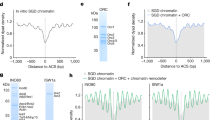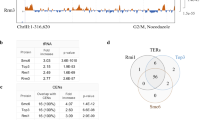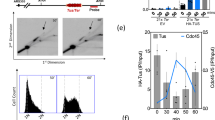Abstract
Heterochromatin is a structurally compacted region of chromosomes in which transcription and recombination are inactivated1,2. DNA replication is temporally regulated in heterochromatin, but the molecular mechanism for regulation has not been elucidated. Among heterochromatin loci in Schizosaccharomyces pombe, the pericentromeric region and the silent mating-type (mat) locus replicate in early S phase, whereas the sub-telomeric region does not3,4,5, suggesting complex mechanisms for regulation of replication in heterochromatic regions. Here, we show that Swi6, an S. pombe counterpart of heterochromatin protein 1 (HP1), is required for early replication of the pericentromeric region and the mat locus. Origin-loading of Sld3, which depends on Dfp1/Dbf4-dependent kinase Cdc7 (DDK), is stimulated by Swi6. An HP1-binding motif within Dfp1 is required for interaction with Swi6 in vitro and for early replication of the pericentromeric region and mat locus. Tethering of Dfp1 to the pericentromeric region and mat locus in swi6-deficient cells restores early replication of these loci. Our results show that a heterochromatic protein positively regulates initiation of replication in silenced chromatin by interacting with an essential kinase.
This is a preview of subscription content, access via your institution
Access options
Subscribe to this journal
Receive 12 print issues and online access
$209.00 per year
only $17.42 per issue
Buy this article
- Purchase on Springer Link
- Instant access to full article PDF
Prices may be subject to local taxes which are calculated during checkout





Similar content being viewed by others
References
Moazed, D. Common themes in mechanisms of gene silencing. Mol. Cell 8, 489–498 (2001).
Peng, J. C. & Karpen, G. H. Epigenetic regulation of heterochromatic DNA stability. Curr. Opin. Genet. Dev. 18, 204–211 (2008).
Hayashi, M. et al. Genome-wide localization of pre-RC sites and identification of replication origins in fission yeast. EMBO J. 26, 1327–1339 (2007).
Kim, S. M., Dubey, D. D. & Huberman, J. A. Early-replicating heterochromatin. Genes Dev. 17, 330–335 (2003).
Kim, S. M. & Huberman, J. A. Regulation of replication timing in fission yeast. EMBO J. 20, 6115–6126 (2001).
Gilbert, D. M. Replication timing and transcriptional control: beyond cause and effect. Curr. Opin. Cell Biol. 14, 377–383 (2002).
Aladjem, M. I. Replication in context: dynamic regulation of DNA replication patterns in metazoans. Nature Rev. Genet. 8, 588–600 (2007).
Grewal, S. I. & Jia, S. Heterochromatin revisited. Nature Rev. Genet. 8, 35–46 (2007).
Nakayama, J., Klar, A. J. & Grewal, S. I. A chromodomain protein, Swi6, performs imprinting functions in fission yeast during mitosis and meiosis. Cell 101, 307–317 (2000).
Klar, A. J. & Bonaduce, M. J. swi6, a gene required for mating-type switching, prohibits meiotic recombination in the mat2-mat3 “cold spot” of fission yeast. Genetics 129, 1033–1042 (1991).
Nakayama, J., Allshire, R. C., Klar, A. J. & Grewal, S. I. A role for DNA polymerase alpha in epigenetic control of transcriptional silencing in fission yeast. EMBO J. 20, 2857–2866 (2001).
Ahmed, S., Saini, S., Arora, S. & Singh, J. Chromodomain protein Swi6-mediated role of DNA polymerase alpha in establishment of silencing in fission yeast. J. Biol. Chem. 276, 47814–47821 (2001).
Bailis, J. M., Bernard, P., Antonelli, R., Allshire, R. C. & Forsburg, S. L. Hsk1-Dfp1 is required for heterochromatin-mediated cohesion at centromeres. Nature Cell Biol. 5, 1111–1116 (2003).
Smith, J. G. et al. Replication of centromere II of Schizosaccharomyces pombe. Mol. Cell Biol. 15, 5165–5172 (1995).
Olsson, T., Ekwall, K. & Ruusala, T. The silent P mating type locus in fission yeast contains two autonomously replicating sequences. Nucleic Acids Res. 21, 855–861 (1993).
Jacobs, S. A. & Khorasanizadeh, S. Structure of HP1 chromodomain bound to a lysine 9-methylated histone H3 tail. Science 295, 2080–2083 (2002).
Yabuuchi, H. et al. Ordered assembly of Sld3, GINS and Cdc45 is distinctly regulated by DDK and CDK for activation of replication origins. EMBO J. 25, 4663–4674 (2006).
Yamada, Y., Nakagawa, T. & Masukata, H. A novel intermediate in initiation complex assembly for fission yeast DNA replication. Mol. Biol. Cell 15, 3740–3750 (2004).
Nakayama, J., Rice, J. C., Strahl, B. D., Allis, C. D. & Grewal, S. I. Role of histone H3 lysine 9 methylation in epigenetic control of heterochromatin assembly. Science 292, 110–113 (2001).
Hall, I. M. et al. Establishment and maintenance of a heterochromatin domain. Science 297, 2232–2237 (2002).
Sadaie, M., Iida, T., Urano, T. & Nakayama, J. A chromodomain protein, Chp1, is required for the establishment of heterochromatin in fission yeast. EMBO J. 23, 3825–3835 (2004).
Cam, H. P. et al. Comprehensive analysis of heterochromatin- and RNAi-mediated epigenetic control of the fission yeast genome. Nature Genet. 37, 809–819 (2005).
Kanoh, J., Sadaie, M., Urano, T. & Ishikawa, F. Telomere binding protein Taz1 establishes Swi6 heterochromatin independently of RNAi at telomeres. Curr. Biol. 15, 1808–1819 (2005).
Kawashima, S. A. et al. Shugoshin enables tension-generating attachment of kinetochores by loading Aurora to centromeres. Genes Dev. 21, 420–435 (2007).
Acknowledgements
We thank Hiroyuki Araki for critical reading and Yoshinori Watanabe for providing CFP-chromodomain constructs. M.T.H. is a Research Fellow of the Japan Society for the Promotion of Science. This study was supported by a Grant-in-Aid for JSPS Fellows to M.T.H., and in part by a Grant-in-Aid to H.M. and to J.N. from the Ministry of Education, Science, Technology, Sports and Culture, Japan.
Author information
Authors and Affiliations
Contributions
M.T.H. and H.M. designed the project and wrote the paper; M.T.H. performed the experiments; J.N. provided important experimental materials and advice. All authors contributed to the interpretation of the results and edited the manuscript.
Corresponding author
Ethics declarations
Competing interests
The authors declare no competing financial interests.
Supplementary information
Supplementary Information
Supplementary Information (PDF 2919 kb)
Rights and permissions
About this article
Cite this article
Hayashi, M., Takahashi, T., Nakagawa, T. et al. The heterochromatin protein Swi6/HP1 activates replication origins at the pericentromeric region and silent mating-type locus. Nat Cell Biol 11, 357–362 (2009). https://doi.org/10.1038/ncb1845
Received:
Accepted:
Published:
Issue Date:
DOI: https://doi.org/10.1038/ncb1845
This article is cited by
-
Control of DNA replication timing in the 3D genome
Nature Reviews Molecular Cell Biology (2019)
-
Cdc7 kinase stimulates Aurora B kinase in M-phase
Scientific Reports (2019)
-
Order from clutter: selective interactions at mammalian replication origins
Nature Reviews Genetics (2017)
-
A replication-time-controlling sequence element in Schizosaccharomyces pombe
Chromosoma (2017)
-
DNA replication origin activation in space and time
Nature Reviews Molecular Cell Biology (2015)



